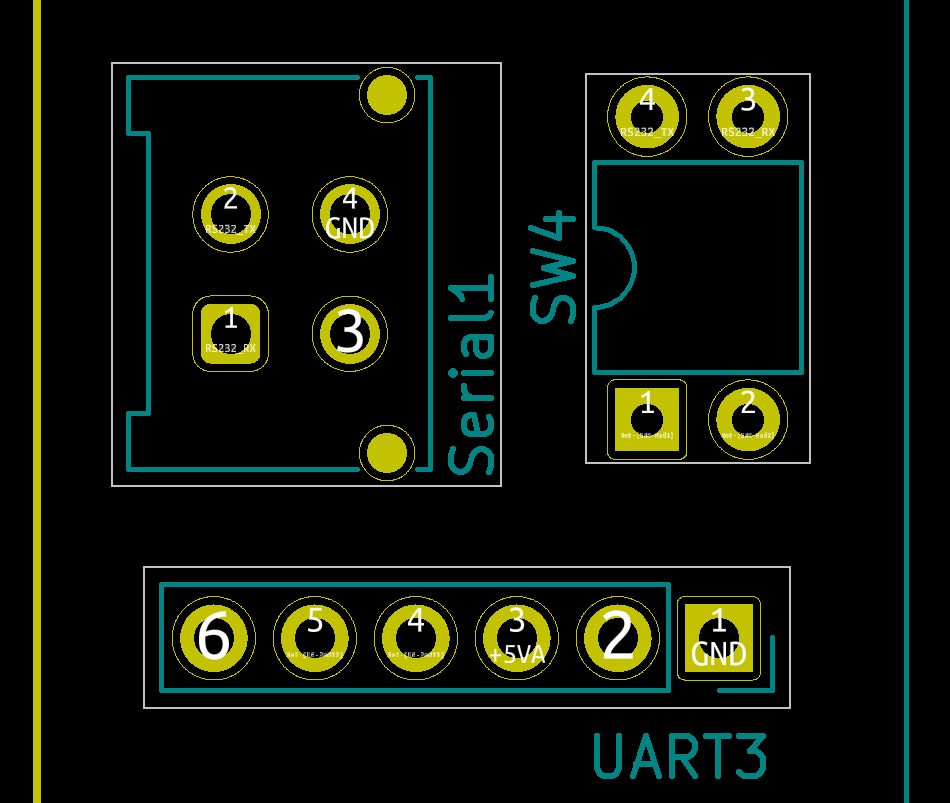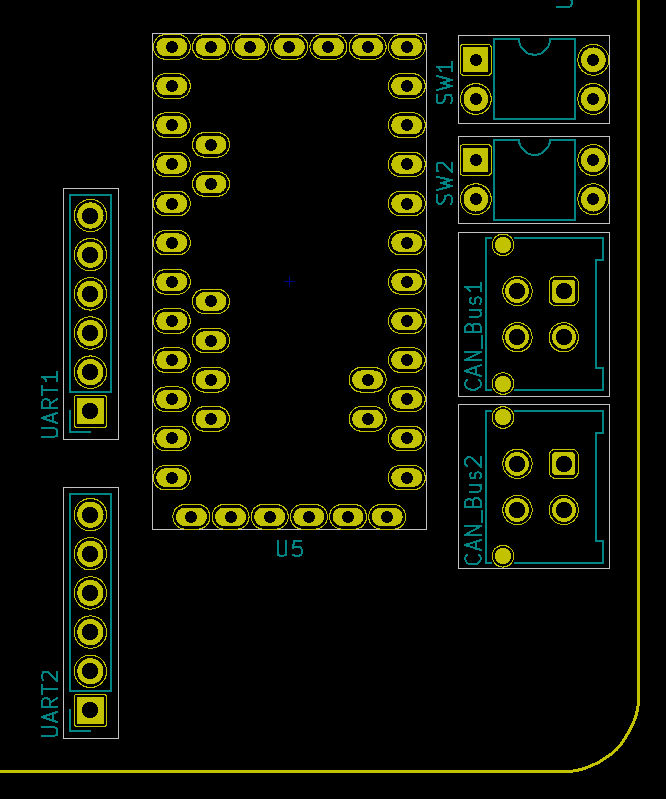EA11R PNP Options and Expansion
The OEM Suzuki ECU has just enough inputs and outputs to drive the F6As EFI functionality. There are not positions in the OEM ECU connector to provide additional IO. In order to provide additional capabilities we have included several options of expansion and connectivity, including UART headers for serial, CAN Bus, and an onboard Arduino microcontroller.
UART Serial
The Microsquirt module communicates with TunerStudio for programming and logging over RS-232. RS-232 is a reliable and robost protocol. It is extremely common in industrial applications, but is not common for customer-facing interfaces in consumer products. As such, many users will not have the hardware to use RS-232. To help our users we’ve translated this to UART and provided a 6-pin header common to many available devices.

The above figure shows the RS-232 and UART connections for the microsquirt module.
Serial1 is a direct RS-232 connection with the Micorsquirt Module. It is compatible with the Innovate Motorsport 3840 Program Cable.
UART3 provides a TTL translation of the Microsquirt’s RS-232 interface.
SW4 connects or disconnects the RS-232 signals from the Microsquirt Module to UART3. When SW4 is in the 1 position UART3 is turned on. RS-232 signals are sent to UART3.
There are several 6-pin UART devices to provide USB communication:
- SparkFun Serial Basic Breakout - CH340C and USB-C
- Adafruit FTDI Serial TTL-232 USB Cable
- Adafruit FTDI Serial TTL-232 USB Type C Cable - 5V Power / 3.3V Logic
- Adafruit CP2104 Friend - USB to Serial Converter
- Adafruit FTDI Friend + extras - v1.0
- Seeed USB To UART 5V
- Seeed USB To UART 5V&3V3
When connecting cable devices, the green wire is on pin 6, closest to the baord’s edge, and then black wire is on pin1, closest to the board center.
There are similar devices from other manufacturers. To be compatible with the Kei Sport USA EA11R PNP the device must operate at 5V. These devices provide a USB port inside of the case. To be compatible with the Kei Sport USA EA11R PNP they need to operate at 5V. A USB cable can then be routed through the gap between the two case halves, or a hole may be made in the case.
Bluetooth devices are also available in the 6 pin form factor:
- Bluefruit EZ-Link - Bluetooth Serial Link & Arduino Programmer - v1.3
- Adafruit Bluefruit LE UART Friend - Bluetooth Low Energy (BLE)
- SparkFun Bluetooth Mate Gold
Some of these devices have been discontinued. They are listed for the sake of documentation and completeness. With these devices, TunerStudio can communicate with the PNP without any additional wires being routed through the case. Because the case is metal and a complete enclosure, the signal will be degraded. As such, the device might not work at longer distances.
Installing UART serial devices
While we are fortunate that these devices use a common 6-pin header, this header is not a robust connection in an environment with vibration. This is not an automotive connector. We do not suggest leaving the UART serial device permanently installed. If you’d like to, there are a few things to consider:
- Use some hot glue to pot the connectors. Slather it around like you’re in a viral DIY crafts video.
- Ensure that there’s a short section of cable inside the case to provide strain relief.
- If you’re using a bluetooth device, fabricate a spacer and use double sided tape.
If you are at all concerned about these solutions, we suggest purchasing an RS-232 to USB cable and use the RS-232 interface.
CAN Bus
The Microsquirt Module includes the ability to communicate over CAN Bus. The Megasquirt-II uses a somewhat unconventional 29-bit format. This is documented in the Megasquirt-2 MS Extra manual. The Microsquirt can also broadcast a more conventional 11-bit format, but it cannot receive information in this format. This makes datalogging from the microsquirt easier. This is documented in the Megasquirt-2 MS Extra manual. Our PNP provides access to the CAN Bus via a 4-pin Molex connector on the PCB and an included DB9 cable. This allows access to the CAN Bus data for dataloggers, dashboards, and external controllers.
CAN Bus devices
A few devices are available which provide additional IO and communicate to the microsquirt module via CAN Bus. To work with the Kei Sport EA11R PNP these CAN Bus devices will live in their own enclosure and communicate with the PNP via a CAN Bus connection. Various Inputs and Outputs will be routed to the device and these will be communicated to the PNP via CAN Bus. These devices use the MS2’s 29-bit CAN format and, therefore, have full two-way communication, allowing the PNP to read from additional sensors or drive additional outputs.
The Bowling and Grippo General Purpose I/O Board is available in the United States from DIYAutoTune as a kit. The JBPerf I/O Extender Board is available directly from JBPerf.
Arduino
In order to facilitate additional use cases, such as logging, IO and interpretation, the PNP is provisioned for an arduino pro mini or SparkFun AST-CAN485. There are two UART headers provided. Components are on board to interpret the Microsquirt’s CAN Bus and this is routed to the SPI interface. A second CAN Bus connection is provided to the native CAN interface of the AST-CAN485. The Microsquirt’s CAN Bus may be connected to either of these interfaces.
The Arduino’s UART interface allows communication using similar hardware as described above. A SparkFun OpenLog device may also be used to provide onboard datalogging of any data.

The above figure shows the CAN Bus connections, Arduino, and UART connections for the onboard Arduino.
In the above figure U5 is the socket for an Arduino. UART1 is a software serial interface. UART2 is a hardware serial interface. SW1 and SW2 are switches to route the Microsquirt’s CAN Bus. CAN_Bus1 and CAN_Bus2 are 4-pin Molex connectors for the CAN Bus interfaces. CAN_Bus1 is connected to the CAN485’s native CAN interface. CAN_Bus2 is connected to the SPI CAN Bus interface.
SW1 connects or disconnects the Microsquirt Module’s CAN Bus to CAN_Bus1. When SW1 is in the 1 the Microsquirt Module’s CAN Bus is available on CAN_Bus1. SW2 connects the Microsquirt’s CAN Bus to CAN_Bus2 in a similar fashion.
CAN_Bus1 and CAN_Bus2 are compatible with the Innovate Motorsport 3840 Program Cable.
Software
There are many libraries available for communicating over CAN with Arduino. SparkFun has provided detailed documentation for working with their AST-CAN485 device. This uses the AST CAN Library from Atlantis Specialist Technologies. This is a more limited library, but is specific to the onboard CAN interface of the AST-CAN485 hardware.
With the SPI CAN interface, there are more library options available. The Longan Labs CAN Bus Library is featureful, well documented, and seems to have clean code.
